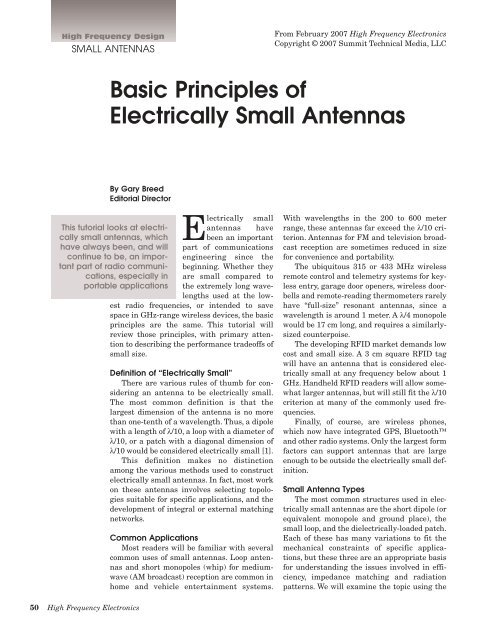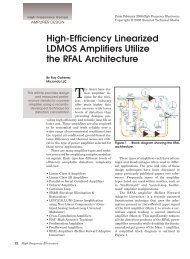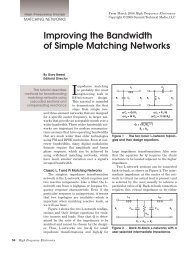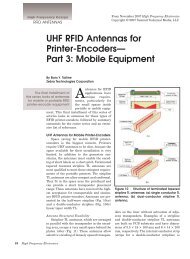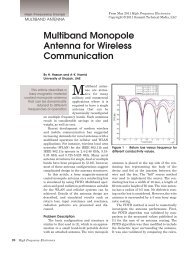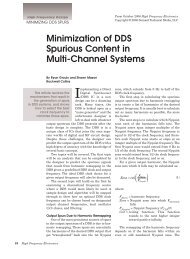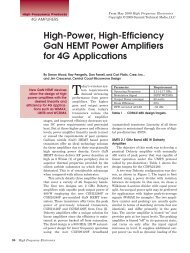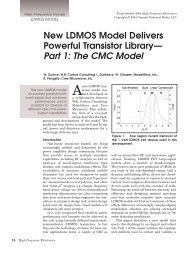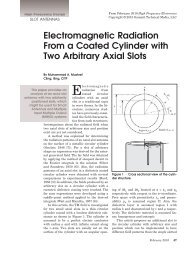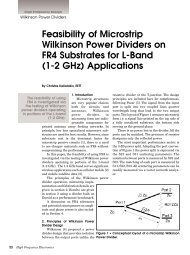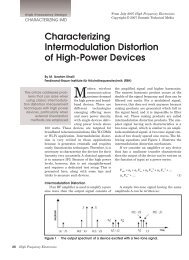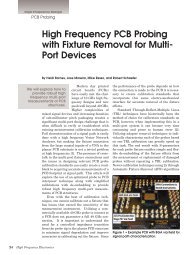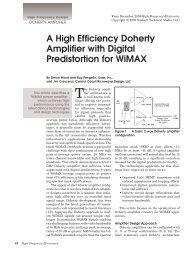Basic Principles of Electrically Small Antennas - High Frequency ...
Basic Principles of Electrically Small Antennas - High Frequency ...
Basic Principles of Electrically Small Antennas - High Frequency ...
You also want an ePaper? Increase the reach of your titles
YUMPU automatically turns print PDFs into web optimized ePapers that Google loves.
<strong>High</strong> <strong>Frequency</strong> Design<br />
SMALL ANTENNAS<br />
From February 2007 <strong>High</strong> <strong>Frequency</strong> Electronics<br />
Copyright © 2007 Summit Technical Media, LLC<br />
<strong>Basic</strong> <strong>Principles</strong> <strong>of</strong><br />
<strong>Electrically</strong> <strong>Small</strong> <strong>Antennas</strong><br />
By Gary Breed<br />
Editorial Director<br />
<strong>Electrically</strong> small<br />
This tutorial looks at electrically<br />
small antennas, which<br />
been an important<br />
antennas have<br />
have always been, and will part <strong>of</strong> communications<br />
continue to be, an important<br />
engineering since the<br />
part <strong>of</strong> radio communi-<br />
cations, especially in<br />
portable applications<br />
beginning. Whether they<br />
are small compared to<br />
the extremely long wavelengths<br />
used at the lowest<br />
radio frequencies, or intended to save<br />
space in GHz-range wireless devices, the basic<br />
principles are the same. This tutorial will<br />
review those principles, with primary attention<br />
to describing the performance trade<strong>of</strong>fs <strong>of</strong><br />
small size.<br />
Definition <strong>of</strong> “<strong>Electrically</strong> <strong>Small</strong>”<br />
There are various rules <strong>of</strong> thumb for considering<br />
an antenna to be electrically small.<br />
The most common definition is that the<br />
largest dimension <strong>of</strong> the antenna is no more<br />
than one-tenth <strong>of</strong> a wavelength. Thus, a dipole<br />
with a length <strong>of</strong> λ/10, a loop with a diameter <strong>of</strong><br />
λ/10, or a patch with a diagonal dimension <strong>of</strong><br />
λ/10 would be considered electrically small [1].<br />
This definition makes no distinction<br />
among the various methods used to construct<br />
electrically small antennas. In fact, most work<br />
on these antennas involves selecting topologies<br />
suitable for specific applications, and the<br />
development <strong>of</strong> integral or external matching<br />
networks.<br />
Common Applications<br />
Most readers will be familiar with several<br />
common uses <strong>of</strong> small antennas. Loop antennas<br />
and short monopoles (whip) for mediumwave<br />
(AM broadcast) reception are common in<br />
home and vehicle entertainment systems.<br />
With wavelengths in the 200 to 600 meter<br />
range, these antennas far exceed the λ/10 criterion.<br />
<strong>Antennas</strong> for FM and television broadcast<br />
reception are sometimes reduced in size<br />
for convenience and portability.<br />
The ubiquitous 315 or 433 MHz wireless<br />
remote control and telemetry systems for keyless<br />
entry, garage door openers, wireless doorbells<br />
and remote-reading thermometers rarely<br />
have “full-size” resonant antennas, since a<br />
wavelength is around 1 meter. A λ/4 monopole<br />
would be 17 cm long, and requires a similarlysized<br />
counterpoise.<br />
The developing RFID market demands low<br />
cost and small size. A 3 cm square RFID tag<br />
will have an antenna that is considered electrically<br />
small at any frequency below about 1<br />
GHz. Handheld RFID readers will allow somewhat<br />
larger antennas, but will still fit the λ/10<br />
criterion at many <strong>of</strong> the commonly used frequencies.<br />
Finally, <strong>of</strong> course, are wireless phones,<br />
which now have integrated GPS, Bluetooth<br />
and other radio systems. Only the largest form<br />
factors can support antennas that are large<br />
enough to be outside the electrically small definition.<br />
<strong>Small</strong> Antenna Types<br />
The most common structures used in electrically<br />
small antennas are the short dipole (or<br />
equivalent monopole and ground place), the<br />
small loop, and the dielectrically-loaded patch.<br />
Each <strong>of</strong> these has many variations to fit the<br />
mechanical constraints <strong>of</strong> specific applications,<br />
but these three are an appropriate basis<br />
for understanding the issues involved in efficiency,<br />
impedance matching and radiation<br />
patterns. We will examine the topic using the<br />
50 <strong>High</strong> <strong>Frequency</strong> Electronics
<strong>High</strong> <strong>Frequency</strong> Design<br />
SMALL ANTENNAS<br />
classic dipole and loop as examples.<br />
For more information on electrically<br />
small patch antennas, readers are<br />
directed to Reference [2].<br />
The Short Dipole<br />
Figure 1(a) shows a short dipole<br />
antenna. At 100 MHz, a λ/10 dipole<br />
with a 1 mm conductor diameter has<br />
an impedance at the center feedpoint<br />
<strong>of</strong> 1.96 –j1758 ohms, as determined<br />
by NEC2 numerical modeling [3].<br />
This low resistance and high capacitive<br />
reactance illustrates that a large<br />
impedance transformation will be<br />
required to match this antenna to a<br />
typical 50 ohm system.<br />
The current distribution on a<br />
short dipole is a portion <strong>of</strong> the cosine<br />
current distribution seen on a halfwave<br />
resonant dipole. In this case,<br />
the current distribution is nearly triangular<br />
(Figure 1(b)). This current<br />
distribution results in the free-space<br />
radiation pattern <strong>of</strong> Figure 1(c), in a<br />
plane containing the antenna wire.<br />
Note that the small size <strong>of</strong> this<br />
antenna does not greatly reduce the<br />
efficiency. The maximum gain <strong>of</strong> 1.77<br />
dBi is only 0.37 dB less than a halfwave<br />
dipole’s 2.14 dBi gain. However,<br />
this is only part <strong>of</strong> the efficiency<br />
story. As will be shown later, the<br />
matching system is the primary contributor<br />
to reduced efficiency in electrically<br />
small antennas.<br />
The <strong>Small</strong> Loop<br />
Figure 2(a) shows a small circular<br />
loop, with a diameter <strong>of</strong> λ/10. The<br />
radiation resistance <strong>of</strong> a small loop<br />
can be calculated from [4]:<br />
R r<br />
= 31,171 (A/λ 2 ) 2<br />
Impedance Matching Issues<br />
The input impedance <strong>of</strong> both the<br />
short dipole and small loop has a<br />
small resistive component and a<br />
large reactive component. Of concern<br />
is the loss within the matching circuitry.<br />
Even with relatively high Q,<br />
large-value reactive components will<br />
have significant resistance that contributes<br />
to system loss.<br />
For example, Figure 3(a) shows an<br />
ideal, lossless matching network to<br />
transform the 1.96 –j1758 ohms <strong>of</strong><br />
the short dipole to 50 ohms system<br />
impedance. Mathematically, this provides<br />
a proper match, albeit narrowband.<br />
However, ideal inductors do not<br />
exist. A practical Q for an inductor is<br />
between 50 and 200, depending on<br />
construction and effects <strong>of</strong> coupling to<br />
the surrounding environment. For a<br />
Q <strong>of</strong> 100, each inductor will have a<br />
resistive loss <strong>of</strong> X L<br />
/Q, or 879/100 =<br />
8.79 ohms. Since there are two inductors,<br />
the total additional resistance in<br />
series with the antenna input is<br />
17.58 ohms. Ignoring the smaller loss<br />
from the capacitor, the finite Q <strong>of</strong> the<br />
inductors results in a loss <strong>of</strong><br />
20log[1.96/(17.58+1.96)] = 21 dB.<br />
Figure 3(b) shows a modified<br />
matching network that accommodates<br />
the additional loss. The different<br />
values demonstrate how an<br />
empirically-derived matching network<br />
(e.g. determined by trial-anderror<br />
experimentation) can get<br />
results that are far from calculated<br />
network values that do not account<br />
for losses.<br />
The matching process is similar<br />
for the small loop, except that the<br />
matching involves a large value <strong>of</strong> X C<br />
instead <strong>of</strong> X L<br />
. Since capacitors have<br />
much higher Q than inductors, it<br />
would seem that small loop matching<br />
would have lower losses than an<br />
equivalent dipole match. This is genλ/10<br />
Z feed = 1.96 –j1758 Ω<br />
(a)<br />
(b)<br />
(c)<br />
Relative current<br />
Max. gain<br />
1.77 dBi<br />
Figure 1 · Short dipole example:<br />
(a) dimensions and impedance;<br />
(b) current distribution, and (c)<br />
radiation pattern and gain.<br />
D = λ/10<br />
(r = λ/20)<br />
R r = 1.92 Ω<br />
Figure 2 · A small loop also has a<br />
low radiation resistance.<br />
where R r<br />
is radiation resistance, the<br />
number 31,171 is 320π 4 , with A (loop<br />
area) and λ (wavelength) in the same<br />
units.<br />
Solving for a λ/10 diameter loop,<br />
where A = π(λ/20) 2 , the radiation<br />
resistance is found to be 1.92 ohms.<br />
The actual feedpoint impedance will<br />
include the resistive loss <strong>of</strong> the conductor<br />
(with skin effect), plus the<br />
inductance <strong>of</strong> the loop, which will<br />
have a result in range <strong>of</strong> 3.0 +j800<br />
ohms. The radiation pattern and gain<br />
are similar to the λ/10 short dipole.<br />
Current distribution is nearly<br />
uniform on a small loop and does not<br />
reveal much about its behavior.<br />
52 <strong>High</strong> <strong>Frequency</strong> Electronics
1.407 µH 1.407 µH 1.42 µH<br />
Q = 100<br />
151 pF 40 pF<br />
1.42 µH<br />
Q = 100<br />
50 Ω 50 Ω<br />
(a)<br />
Figure 3 · Short dipole matching: (a) ideal lossless components, and (b)<br />
values required for practical inductors with a Q <strong>of</strong> 100.<br />
(b)<br />
erally true, but note that the loop<br />
example occupies an area much larger<br />
than the example dipole. A loop<br />
that is more comparable to the dipole<br />
in its physical dimensions will be<br />
smaller and have a lower value <strong>of</strong> R r<br />
,<br />
which will increase matching network<br />
losses.<br />
Mitigating the Loss Problem<br />
Many technical papers and<br />
patents describe alterations in the<br />
structure <strong>of</strong> small antennas in ways<br />
that increase the radiation resistance<br />
and/or implement lower loss matching<br />
technqiues. Loading—the addition<br />
<strong>of</strong> capacitive or inductive elements,<br />
both lumped and integral to<br />
the antenna, is the most common<br />
group. Top hats, folded elements, 3-<br />
dimensional structures, dielectric<br />
foreshortening and other methods<br />
are commonly used to add electrical<br />
length to a small antenna, raising the<br />
radiation resistance.<br />
Often—perhaps too <strong>of</strong>ten—the<br />
inefficiency <strong>of</strong> a small antenna is just<br />
included in the link budget calculations<br />
and overcome by increased system<br />
gain, transmit power or simply<br />
accepting reduced communication<br />
range. This may work for some applications,<br />
but all these consequences<br />
are detrimental to system performance,<br />
decreasing performance and<br />
shortening battery life. A useful<br />
reduction <strong>of</strong> losses in the antenna<br />
and matching network can be easy<br />
and cheap, but requires the designer<br />
to be aware that such an improvement<br />
can be obtained.<br />
Hopefully, this tutorial raises the<br />
awareness <strong>of</strong> loss and efficiency<br />
issues with small antennas. The next<br />
step is to learn some <strong>of</strong> the options<br />
for getting better performance for<br />
future product designs.<br />
References<br />
1. D. Miron, <strong>Small</strong> Antenna<br />
Design, Newnes 2006.<br />
2. R. Garg, P. Bhartia, Inder Bahl<br />
and A. Ittipiboon, Microstrip Antenna<br />
Design Handbook, Artech House<br />
2001.<br />
3. As implemented in EZNEC+ by<br />
Roy Lewallen, www.eznec.com.<br />
4. J. Kraus, <strong>Antennas</strong>, McGraw-<br />
Hill 1950, Ch. 6, section 6-8.


